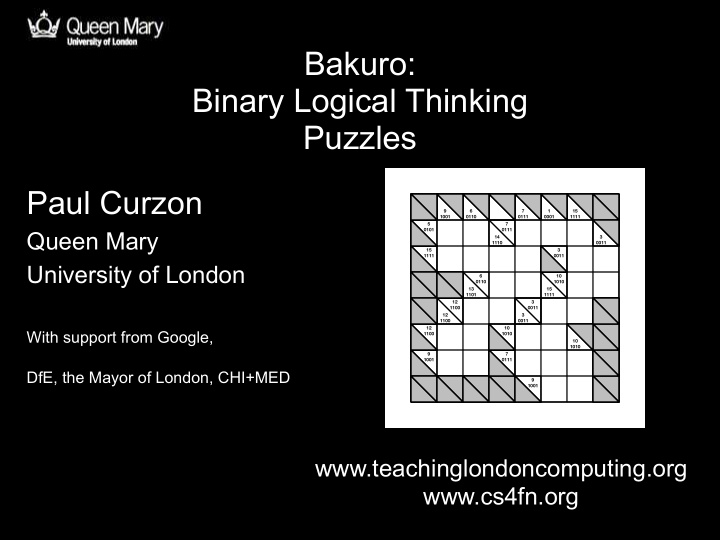



Bakuro: Binary Logical Thinking Puzzles Paul Curzon 9 6 7 1 15 1001 0110 0111 0001 1111 5 7 0101 0111 Queen Mary 14 3 1110 0011 15 3 1111 0011 University of London 6 10 0110 1010 13 15 1101 1111 12 3 1100 0011 12 3 1100 0011 12 10 With support from Google, 1100 1010 10 1010 9 7 DfE, the Mayor of London, CHI+MED 1001 0111 9 1001 www.teachinglondoncomputing.org www.cs4fn.org
A simple example puzzle • Fill the grid using only powers of 2 (1,2,4,8) • Horizontal (vertical) blocks must add to 9 6 1001 0110 the number on the left 3 0011 (above) • Fill in the binary of the 12 1100 answers too
A simple example puzzle • Each number has a unique sum • Work values out from the intersection of 9 6 sums 1001 0110 3 1 0011 • 3 = 1 + 2 0001 • 9 = 1 + 8 12 1100
A simple example puzzle • 3 = 2 + 1 • 6 = 2 + 4 9 6 1001 0110 The binary tells you the 3 1 2 0011 numbers! 0001 0010 12 1100 0011 = 0010 + 0001 3 = 2 + 1
A simple example puzzle • 12 = 8 + 4 • 6 = 2 + 4 9 6 1001 0110 3 1 2 0011 • 9 = 8 + 1 0001 0010 12 8 4 1100 Now you have the 1000 0100 basics, do a harder version
9 6 7 1 15 1001 0110 0111 0001 1111 5 7 0101 0111 14 3 1110 0011 15 3 1111 0011 6 10 0110 1010 13 15 1101 1111 12 3 1100 0011 12 3 1100 0011 12 10 1100 1010 10 1010 9 7 1001 0111 9 1001 6
Extension Activity • Get the students to invent their own based on blank grids • They must check it is solvable! • Then create ones from a blank sheet of squared paper
Summary • Learn fundamentals of binary and logical thinking • Lots of practice at binary • more fun than lists of binary-decimal conversions to do • also focusses on underlying construction • Puzzles are a good way to explore and learn many computing and computational thinking ideas
More support On our website contains: • Activity sheets • Booklets • Slides • Lots more stories For teachers: www.teachinglondoncomputing.org For students: www.cs4fn.org Twitter: @TeachingLDNComp @cs4fn
Recommend
More recommend